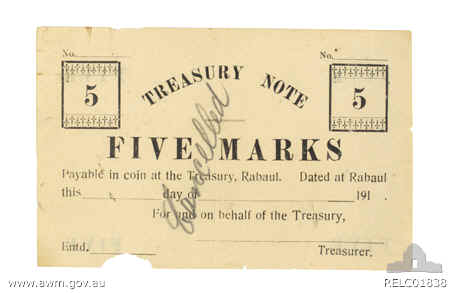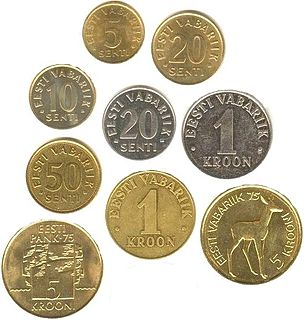
The kroon was the official currency of Estonia for two periods in history: 1928–1940 and 1992–2011. Between 1 January and 14 January 2011, the kroon circulated together with the euro, after which the euro became the sole legal tender in Estonia. The kroon was subdivided into 100 cents. The word kroon is related to that of the Nordic currencies and derived from the Latin word corona ("crown"). The kroon succeeded the mark in 1928 and was in use until the Soviet invasion in 1940 and Estonia's subsequent incorporation into the Soviet Union when it was replaced by the Soviet ruble. After Estonia regained its independence, the kroon was reintroduced in 1992 and replaced by the euro in 2011.

The rupee is the currency of the Seychelles. It is subdivided into 100 cents. In the local Seychellois Creole (Seselwa) language, it is called the roupi and roupie in French. The international currency code is SCR. The abbreviation SR is sometimes used. By population, Seychelles is the smallest country to have an independent monetary policy. Several other currencies are also called rupee.
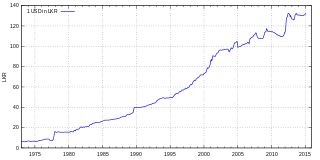
The Sri Lankan Rupee is the currency of Sri Lanka. It is subdivided into 100 cents, but cents are rarely seen in circulation due to its low value. It is issued by the Central Bank of Sri Lanka. The symbol ₨ is generally used, but the currency code "LKR" is occasionally used to distinguish it from other currencies also called rupee.

The Papiermark was the German currency from 4 August 1914 when the link between the Goldmark and gold was abandoned, due to the outbreak of World War I. In particular, the Papiermark was the currency issued during the hyperinflation in Germany of 1922 and 1923.

The Australian pound was the currency of Australia from 1910 until 14 February 1966, when it was replaced by the Australian dollar. As with other £sd currencies, it was subdivided into 20 shillings, each of 12 pence.

The Rentenmark was a currency issued on 15 November 1923 to stop the hyperinflation of 1922 and 1923 in Weimar Germany, after the previously used "paper" Mark had become almost worthless. It was subdivided into 100 Rentenpfennig and was replaced in 1924 by the Reichsmark.

The German mark was the currency of the German Empire, which spanned from 1871 to 1918. The mark was paired with the minor unit of the pfennig (₰); 100 pfennigs were equivalent to 1 mark. The mark was on the gold standard from 1871–1914, but like most nations during World War I, the German Empire removed the gold backing in August 1914, and gold and silver coins ceased to circulate.

The kina is the currency of Papua New Guinea. It is divided into 100 toea. The name kina is derived from Kuanua language of the Tolai region, referring to a callable pearl shell used widely for trading in both the Coastal and Highlands areas of the country.

The dollar has been the currency of Liberia since 1943. It was also the country's currency between 1847 and 1907. It is normally abbreviated with the sign $, or alternatively L$ or LD$ to distinguish it from other dollar-denominated currencies. It is divided into 100 cents.
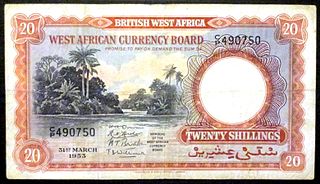
The British West African Pound was the currency of British West Africa, a group of British colonies, protectorates and mandate territories. It was equal to the pound sterling and was similarly subdivided into 20 shillings, each of 12 pence.

The pound was the currency of the Union of South Africa from the formation of the country as a British Dominion in 1910. It was replaced by the rand in 1961 when South Africa became a republic.

The lira was the currency of San Marino from the 1860s until it was replaced by the Euro on 1 January 2002. It was equivalent and pegged to the Italian lira. Italian coins and banknotes and Vatican City coins were legal tender in San Marino, while Sammarinese coins, minted in Rome, were legal tender throughout Italy, as well as in the Vatican City.

The Somalo was the currency of the Trust Territory of Somaliland administered by Italy between 1950 and 1960. The "Somalo" remained officially in use in the newly created Somali Republic until 1962. It was subdivided into 100 centesimi.
The real was the currency of Portuguese Guinea until 1914. It was equal to the Portuguese real. Paper money specifically for Portuguese Guinea was first issued in 1909, supplementing Portuguese currency. Denominations were between 1000 réis and 50 mil réis.
The pound was the currency of Western Samoa between 1914 and 1967. It was subdivided into 20 shillings, each of 12 pence.
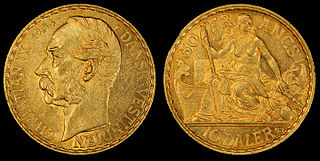
The daler was the currency of the Danish West Indies between 1849 and 1917, and of the United States Virgin Islands between 1917 and 1934.

The dollar was the currency of the colony and, later, Dominion of Newfoundland from 1865 until 1949, when Newfoundland became a province of Canada. It was subdivided into 100 cents.
The pound was the currency of Bermuda until 1970. It was equivalent to the pound sterling, alongside which it circulated, and was similarly divided into 20 shillings each of 12 pence. Bermuda decimalised in 1970, replacing the pound with the Bermudian dollar at a rate of 1 dollar = 8 shillings 4 pence, equal to the U.S. dollar.
Banknotes were issued in New Guinea in late 1914 after Australian forces took over German New Guinea.

Banknotes of the Australian pound were first issued by numerous private banks in Australia, starting with the Bank of New South Wales in 1817. Acceptance of private bank notes was not made compulsory by legal tender laws but they were widely used and accepted. The Queensland government issued treasury notes (1866–1869) and banknotes (1893–1910), which were legal tender in Queensland. The New South Wales government issued a limited series of Treasury Notes in 1893.
